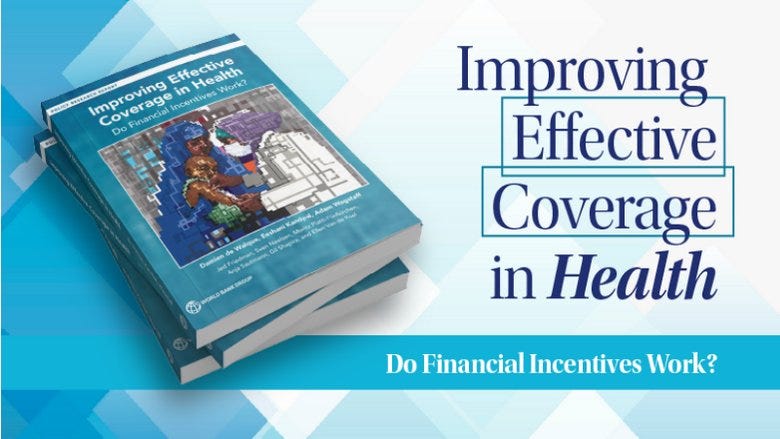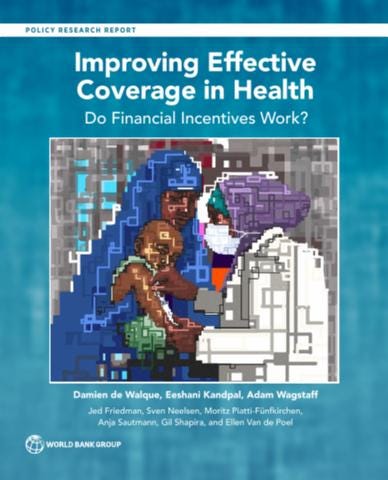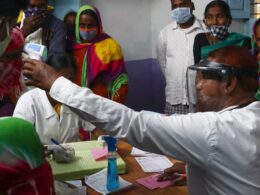The World Bank (World Bank Group)
Damien de Walque, Eeshani Kandpal, Adam Wagstaff
Jed Friedman, Sven Neelsen, Moritz Piatti-Fünfkirchen, Anja Sautmann, Gil Shapira, and Ellen Van de Poel
March, 2022
Report Highlights
- Since the late 2000s, more than US$2.5 billion has been invested in Performance-Based Financing (PBF) projects in primary health service delivery in low-income countries, a significant departure from previous financing models, which had little link to outcomes and results.
- A new Policy Research Report draws on evidence accumulated over 15 years in nearly 40 countries to examine the results of PBF.
- PBF projects produced gains in health outcomes compared to business-as-usual, but these gains did not necessarily result from the specific financial incentives and associated monitoring components of projects.
- Instead, impactful health financing reform may mean pivoting from performance pay while retaining other important aspects of PBF projects — like transparency, accountability, and decentralized frontline financing.

About the Report
In many low- and middle-income countries, health coverage has improved dramatically in the past two decades, but health outcomes have not.
As such, effective coverage — a measure of service delivery that meets a minimum standard of quality — remains unacceptably low.
Improving Effective Coverage in Health: Do Financial Incentives Work? examines one specific policy approach to improving effective coverage: financial incentives in the form of performance-based financing (PBF), a package reform that typically includes performance pay to frontline health workers as well as facility autonomy, transparency, and community engagement.
In many low- and middle-income countries, health coverage has improved dramatically in the past two decades, but health outcomes have not.
As such, effective coverage — a measure of service delivery that meets a minimum standard of quality — remains unacceptably low.
This Policy Research Report draws on a rich set of rigorous studies and new analysis.
When compared with business-as-usual, in low-income settings with centralized health systems PBF can result in substantial gains in effective coverage.
However, the relative benefits of PBF — the performance pay component in particular — are less clear when it is compared with two alternative approaches,
- direct facility financing, which provides operating budgets to frontline health services with facility autonomy on allocation, but not performance pay, and
- demand-side financial support for health services (that is, conditional cash transfers and vouchers).
Although PBF often results in improvements on the margins, closing the substantial gaps in effective health coverage is not yet within reach for many countries.
Nonetheless, important lessons and experiences from the rollout of PBF over the past decade can guide health financing into the future.
In particular, to be successful, health financing reform may need to pivot from performance pay while retaining the elements of direct facility financing, autonomy, transparency, and community engagement.
There are more than six million deaths from preventable causes each year. We need to focus on making sure people across the developing world have access to the quality medical care they need to prosper and achieve their full potential. — Carmen Reinhart,
World Bank Senior Vice President and Chief Economist
Key Messages
- Financial incentives or performance pay to frontline health facilities and workers emerged as an innovative means to improve the quantity and quality of health services delivered.
This approach to health financing arose from the frustrating status quo of poor health outcomes in low- and middle-income countries despite increased service utilization. - This report provides new evidence and reviews the existing literature to assess the results from the introduction of such financial incentives.
- The report pays special attention to impacts on effective coverage, a measure that adjusts simple coverage of care with the quality of care provided.
- It asks which constraints to poor quality of care can be addressed by financial incentives for health workers.
- It further asks what has been the impact of such incentives in general on utilization and quality of care.
- Finally, it asks how offering these incentives compares with some key policy alternatives: cash transfers, vouchers, and direct financing of frontline facilities.
- A range of rigorous studies show that performance-based financing (PBF) projects, which include performance pay among other critical features, including transparency and accountability reforms, resulted in gains in coverage but far fewer, if any, improvements in the quality of health services delivered.
- Compared with business-as-usual, PBF projects offer gains of a similar magnitude as those from direct facility financing (DFF) approaches, which transfer equivalent funds and have transparency and accountability reforms as do PBF projects but do not have specific incentives for health workers and the associated monitoring.
At a time when COVID-19 pandemic has increased mortality and morbidity and caused severe disruptions to routine health services, it is extremely important to focus on the most effective reforms to improve access to high-quality health care. This is an unprecedented opportunity to rethink the way countries build health systems, finance them, and deliver services towards the goal of health for all.
Mamta Murthi
World Bank Vice President for Human Development

Foreword
Countries have made years of significant progress to improve access to health services.
However, important gaps in equity of access to high-quality health care remain due to fragile primary health care systems.
And now, the COVID-19 (coronavirus) pandemic has put decades of progress at risk.
The question we all face now is how to reclaim prepandemic gains while accelerating equity and progress for greater impacts and health for all.
The question we all face now is how to reclaim prepandemic gains while accelerating equity and progress for greater impacts and health for all.
Financial incentives or performance pay to frontline health facilities and workers were rolled out in many countries in the mid-2000s as an innovative approach to confronting the challenge of poor health outcomes in low-income economies.
It was a significant departure from previous financing models, which had little link to outcomes and results.
Performance-based financing (PBF) projects included such financial incentives as well as other critical reforms related to transparency and accountability.
Moreover, these new projects were accompanied by an extensive portfolio of impact evaluations funded by the World Bank’s Health Results Innovation Trust Fund.
These programs — and, indeed, this report — would not have been possible without the unprecedented multidisciplinary collaboration between client governments and World Bank research and operational staff, spanning 15 years and nearly 40 countries, driven by the desire to not only inform country programs with rigorous evidence but also contribute to the global dialogue on improving health systems.
Improving Effective Coverage in Health: Do Financial Incentives Work? builds on this substantial investment in knowledge and evidence in this critical area to examine the results from PBF.
Although focused on low-income countries and primary services, the scope of the studies is impressive.
The largest programs studied here, such as those in Argentina, Cameroon, Nigeria, Tajikistan, Rwanda, and Zimbabwe, each covered millions of households.
The report collates this work and brings additional analysis to provide an assessment of the evidence on performance pay specifically as well as of the broader results from PBF projects.
Several powerful, high-level findings emerge from this report.
The report documents that PBF projects produced gains in health outcomes compared with the status quo, although these gains did not necessarily result from the specific financial incentives and associated monitoring components of projects.
Whereas transparency, accountability, and direct frontline facility financing produced results, the evidence does not show additional benefits that outweigh the costs of performance pay to frontline workers.
Specifically, many aspects of quality care improvements are well outside the control of health workers.
Thus, impactful health financing reform might mean pivoting from performance pay while retaining other important aspects of PBF projects that do yield similar results.
The report also looks at the demand side, emphasizing that cash transfers and vouchers can be part of the solution for more effective coverage in low-demand settings.
The operational and policy messages in this report are compelling, as detailed in the concluding chapter.
Health facilities can deliver better results when they have budget autonomy, flexibility, and unified payment systems, and health facilities’ budgets can be output oriented and impactful even without explicit performance pay.
In contexts in which the time might be right for performance pay, emerging technologies can be used to reduce implementation costs of rollout and monitoring.
Although the analysis in this report draws on evidence that predates the COVID-19 crisis, the findings are more critical than ever as the world navigates recovery and has an unprecedented opportunity to rethink the way countries build health systems, finance them, and deliver services toward the goal of health for all.
Carmen M. Reinhart
Senior Vice President of Development Economics and Chief Economist
The World Bank
Mamta Murthi
Vice President Human Development
The World Bank
March 2022

Outline of the report
Improving Effective Coverage in Health: Do Financial Incentives Work? is arranged as follows:
· Overview
The Overview provides a summary of the key findings and messages of the report.
· Chapter 1: Introduction
Chapter 1 describes the lay of the land in the service delivery of maternal and child health care, focusing on how care is financed with and without additional demand- or supply-side incentives.
It also introduces the conundrum of increasing coverage but persistently poor health outcomes, which motivates the need to look at effective coverage and financial incentives for effective coverage.
· Chapter 2: Effective Coverage: A Framework Linking Coverage and Quality —
Chapter 2 attempts to answer the question “What is effective coverage, what are its implications for efficiency?”
· Chapter 3: Quality of Care: A Framework for Measurement
Chapter 3 focuses on the question “How does quality of care relate to effective coverage, how to measure it, and what constrains it?”
· Chapter 4: Decomposing the Constraints to Quality of Care Using Data on Antenatal Care Consultations from Five Sub-Saharan African Countries —
Chapter 4 presents new evidence on the constraints to quality of antenatal care.
· Chapter 5: Performance-Based Financing Improves Coverage of Reproductive, Maternal, and Child Health Interventions
Chapter 5 presents evidence on the impact of performance-based financing on service delivery, quality of care, human resources, and equity thus far.
· Chapter 6: Policy Alternatives to Performance-Based Financing
Chapter 6 offers key counterfactuals, including demand-side incentives and direct facility financing, using a systematic review and pooled analysis.
It presents a deep dive into direct facility financing.
· Chapter 7: Performance-Based Financing as a Health System Reform and Cautionary Evidence on Performance Pay and Irrelevant Care
Chapter 7 describes the role of performance-based financing in the development of health systems: avoiding nonindicated care and wasted resources, integrating quality measurement into health systems, and measuring the broader impacts of health financing reform.
· Chapter 8: Conclusion and Operational Implications
Chapter 8 operationalizes key aspects of performance-based financing given the evidence presented.
Key messages
1. Financial incentives or performance pay to frontline health facilities and workers emerged as an innovative means to improve the quantity and quality of health services delivered.
This approach to health financing arose from the frustrating status quo of poor health outcomes in low- and middle-income countries despite increased service utilization.
2. This report provides new evidence and reviews the existing literature to assess the results from the introduction of such financial incentives.
a. The report pays special attention to impacts on effective coverage, a measure that adjusts simple coverage of care with the quality of care provided.
b. It asks which constraints to poor quality of care can be addressed by financial incentives for health workers.
c. It further asks what has been the impact of such incentives in general on utilization and quality of care.
d. Finally, it asks how offering these incentives compares with some key policy alternatives: cash transfers, vouchers, and direct financing of frontline facilities.
3. A range of rigorous studies show that performance-based financing (PBF) projects, which include performance pay among other critical features, including transparency and accountability reforms, resulted in gains in coverage but far fewer, if any, improvements in the quality of health services delivered.
4. Compared with business-as-usual, PBF projects offer gains of a similar magnitude as those from direct facility financing (DFF) approaches, which transfer equivalent funds and have transparency and accountability reforms as do PBF projects but do not have specific incentives for health workers and the associated monitoring
5. Policy makers may find PBF appealing because of the accountability provided by its link to results.
DFF reforms should thus incorporate measures like portals or dashboards that track the flow of funds and provide timely information on the quality and efficiency of health care delivery.
In addition, performance pay or household targeted cash transfers may supplement the financing of improvements in selected indicators.
About the authors
This report was produced by a team led by Damien de Walque, Eeshani Kandpal, and Adam Wagstaff, with Jed Friedman, Sven Neelsen, Moritz Piatti-Fünfkirchen, Anja Sautmann, Gil Shapira, and Ellen Van de Poel.
Acknowledgements
This report was developed under the leadership of Adam Wagstaff, who was the manager of the Development Research Group’s Human Development Team at the time of his passing, at the age of 61, on May 10, 2020. Adam needs no introduction as one of the world’s leading lights on health financing and health system reform.
https://www.worldbank.org/en/research/publication/improving-effective-coverage-in-health












